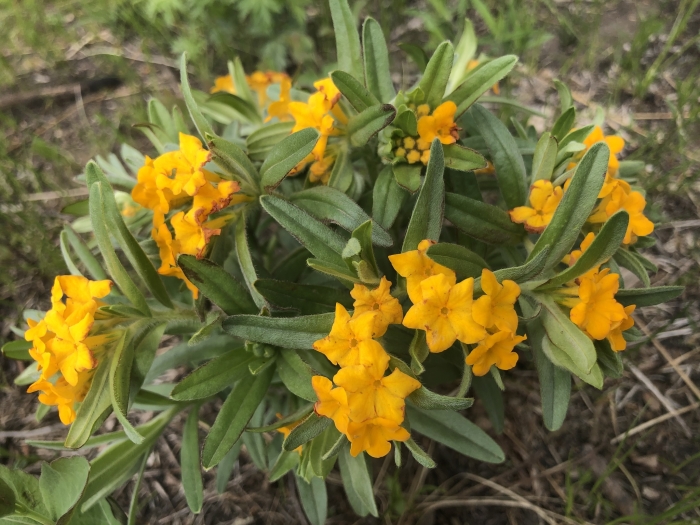Hoary Puccoon
(Lithospermum canescens)
Hoary Puccoon (Lithospermum canescens)
/
/

Andrea Romero
CC BY 4.0
Image By:
Andrea Romero
Recorded By:
Copyright:
CC BY 4.0
Copyright Notice:
Photo by: Andrea Romero | License Type: CC BY 4.0 | License URL: http://creativecommons.org/licenses/by/4.0/ | Rights Holder: Andrea Romero | Publisher: iNaturalist | Date Created: 2020-05-07T01:20:52Z |
















































Estimated Native Range
Summary
Lithospermum canescens, commonly known as Hoary Puccoon, is a deciduous perennial herb that is native to a variety of habitats including prairies, glades, and open woodlands in the Central and Eastern USA, as well as Manitoba, Canada. It typically grows to a height of 6–16 inches (150–410 mm) and features a thick, red, woody taproot with one to several stems that are usually unbranched. The plant’s leaves are narrow and covered with fine white hairs, giving it a hoary appearance. Its flowers are tubular, clustering at the terminal racemes, or at the end of stems, and are typically bright yellow to orange, about 0.5 inches (13 mm) in diameter, and bloom from April to May. The flowers are quite showy and attract pollinators such as bees.
Hoary Puccoon is valued for its vibrant flowers and is used in native plant gardens, prairie restorations, and xeriscaping due to its drought tolerance. It is also appreciated for its historical use as a dye plant by Indigenous peoples. This plant is well-suited for full sun conditions and thrives in well-drained soils, preferring sandy or rocky substrates. It is relatively low maintenance, requiring minimal watering once established. While generally pest-free, it can suffer from root rot in poorly drained soils.CC BY-SA 4.0
Hoary Puccoon is valued for its vibrant flowers and is used in native plant gardens, prairie restorations, and xeriscaping due to its drought tolerance. It is also appreciated for its historical use as a dye plant by Indigenous peoples. This plant is well-suited for full sun conditions and thrives in well-drained soils, preferring sandy or rocky substrates. It is relatively low maintenance, requiring minimal watering once established. While generally pest-free, it can suffer from root rot in poorly drained soils.CC BY-SA 4.0
Plant Description
- Plant Type: Herb
- Height: 1-1.5 feet
- Width: 0.5-1.5 feet
- Growth Rate: Moderate
- Flower Color: Yellow, Orange
- Flowering Season: Spring
- Leaf Retention: Deciduous
Growth Requirements
- Sun: Full Sun
- Water: Low, Medium
- Drainage: Medium, Fast
Common Uses
Bee Garden, Butterfly Garden, Groundcover, Low Maintenance, Showy Flowers
Natural Habitat
Prairies, glades, and open woodlands in the Central and Eastern USA, as well as Manitoba
Other Names
Common Names: Indian-Paint, Puccoon, Hoary Gromwell, Grémil Blanchâtre
Scientific Names: , Lithospermum canescens, Batschia canescens, Lithospermum canescens f. pallidum, Lithospermum sericeum, Anchusa canescens, Batschia conspicua, Batschia sericea, Lithospermum conspicuum, Myosotis canescens,
GBIF Accepted Name: Lithospermum canescens (Michx.) Lehm.